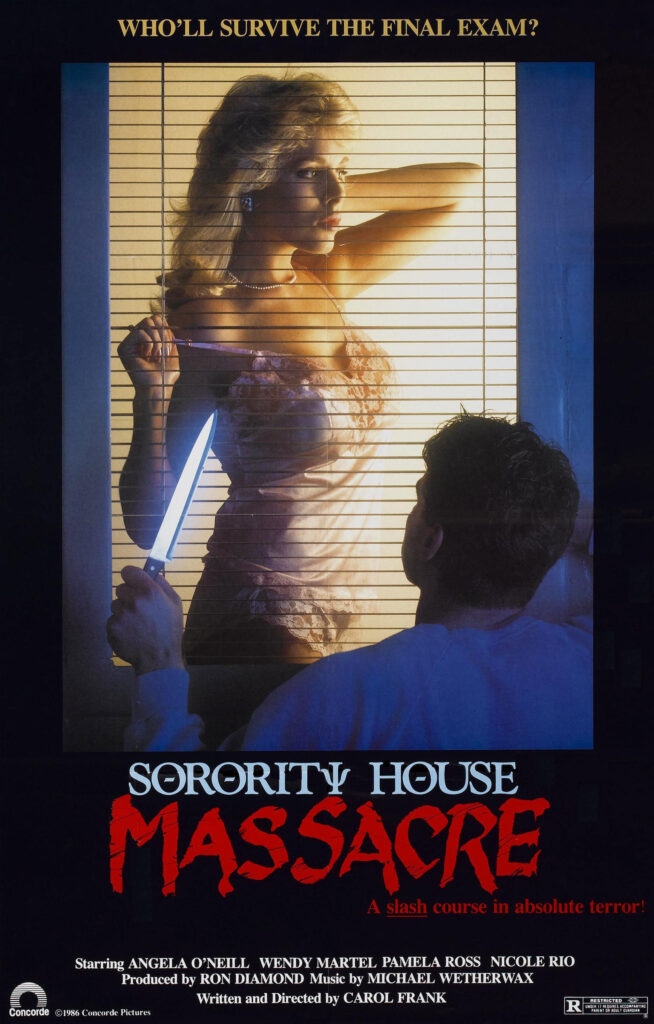Ecclesiastes 1:9 states, “What has been will be again, what has been done will be done again; there is nothing new under the sun.” Every single maker of slasher flicks in the 1980s must have read that verse and taken it to heart. Especially Carol Frank, writer/director of 1986’s Sorority House Massacre. Not only does her movie crib from a decade’s worth of slasher flicks, it also cribs from The Slumber Party Massacre, a film on which Frank worked. According to the internet, so it must be true, that similitude was intentional, as Roger Corman, the uncredited executive producer, wanted a flick with a slumber party theme.
Angela O’Neill stars as Beth, a college student invited to sleep over at a sorority house for a weekend by her friend, Linda (Wendy Martel), while most of the ladies are away. Everything was just fine for Beth until she crossed the threshold. Afterwards, she becomes plagued by hallucinations and nightmares about a knife wielding psychopath. The psychopath is not some creation of her imagination. Rather,  he’s Bobby Henkel (John C. Russell), a patient at a local psychiatric hospital who, until Beth entered the house, was meek and non-vocal. Now, he’s awake, bloodthirsty, and ready to hit the road.
he’s Bobby Henkel (John C. Russell), a patient at a local psychiatric hospital who, until Beth entered the house, was meek and non-vocal. Now, he’s awake, bloodthirsty, and ready to hit the road.
Back at the sorority house, the crowded environs have cleared out, leaving viewers with the right amount of fodder for a slasher flick: four girls and three guys. Beth’s delusions get worse as Bobby escapes the hospital and makes his way to the sorority house, because of a psychic connection or somesuch, similar to the trope used in the Halloween flicks.
Sorority House Massacre clocks in at just 74 minutes in length, yet it kind of meanders about up until the final act. There is requisite storytelling and character development, yet nothing unique enough to make these sequences compelling. The first two acts feel more like a toll a viewer must pay to get to the good stuff. About the only crumb Frank throws us before all the bloodletting is some of the clumsiest nudity one will see in a slasher. It manages to be both gratuitous and vapid. For that combination alone, I salute you, Ms. Frank.
It’s the final act that saves this movie. When Bobby arrives at the house, all hell breaks loose. He chases characters all over the place, and unlike many other slashers, not all the kills are telegraphed. The kills are nasty, even though they are light on blood for the era. It’s the brutality rather than the spectacle that makes them work. Bobby’s weapon of choice is a hunting knife, and Frank used many, many shots of that blade plunging into flesh. The cast looked terrified as it was happening, as well.
Acting, story — those things could have been better, sure. In fact, this is not that good of a film. I was having a hard time staying engaged, ready to watch a climax that would lull me softly into sleep for the evening. Bobby’s run through the sorority house was like leaping into a hot tub full of coffee. It was exciting, engaging, terrifying, and left me wondering how Frank could assemble such a grand finale for a movie that had been wallowing.
For fans of slasher flicks, Sorority House Massacre isn’t a bad choice, although it’s an unbalanced load. For those looking for fine cinema or high art, a low-budget slasher flick from the Roger Corman stable would never be a consideration, anyway.
